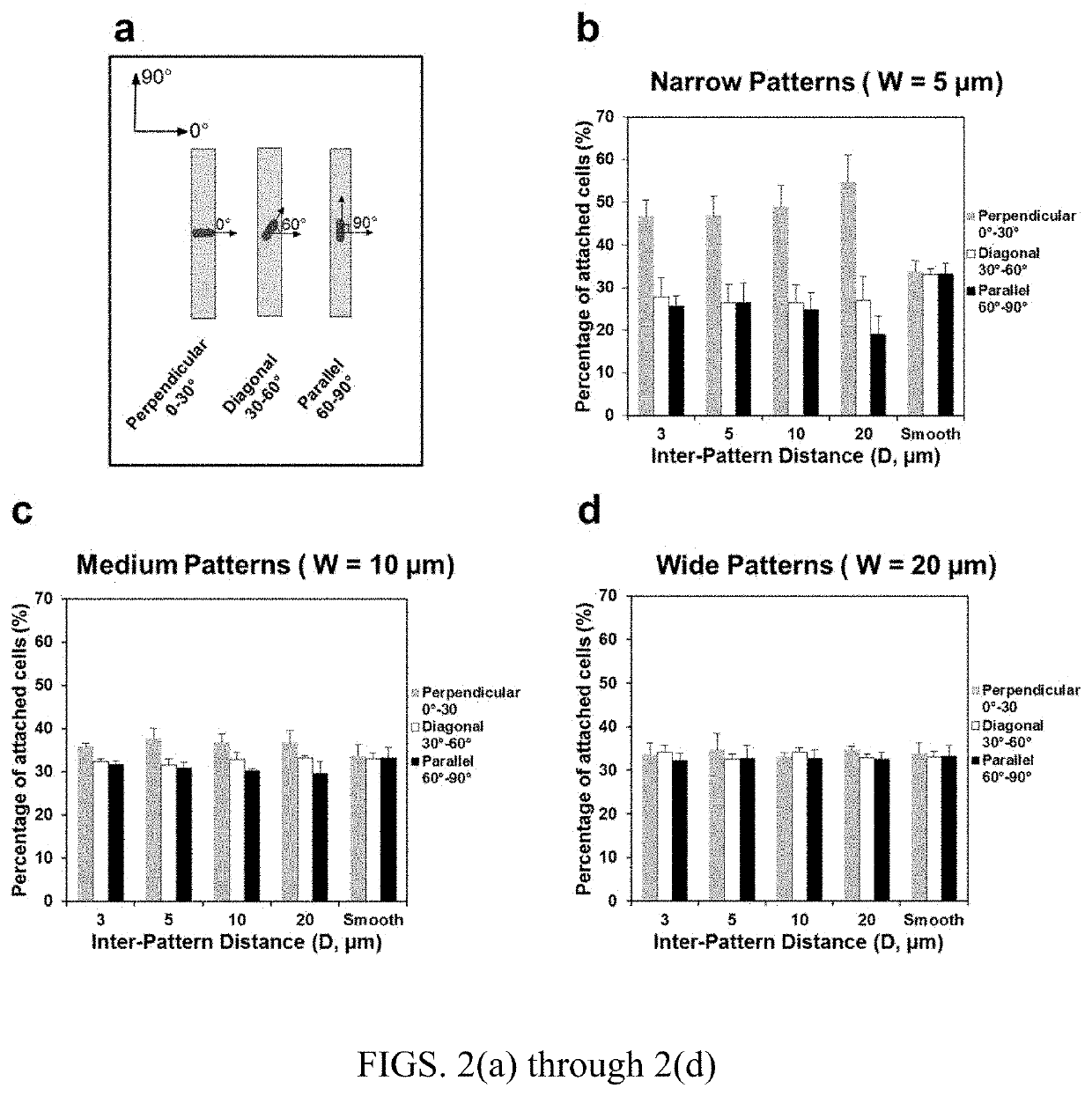Antifouling urinary catheters with shape-memory topographic patterns
a topographic pattern and urinary catheter technology, applied in the field of medical devices, can solve the problems of biofilm infections in common medical devices, affecting the health of patients, and affecting the treatment effect of patients, and achieving the effects of reducing the risk of biofilm infections, and improving the quality of li
- Summary
- Abstract
- Description
- Claims
- Application Information
AI Technical Summary
Benefits of technology
Problems solved by technology
Method used
Image
Examples
example 1
[0037]In light of the finding that the attachment of E. coli cells on 10 μm tall protruding square shaped PDMS patterns is significant only if the patterns are 20 μm×20 μm or bigger on face-up patterns and 40 μm×40 μm or bigger on face-down patterns, surface topography was believed to affect cell orientation and cell cluster formation during biofilm formation. In order to explore that conclusion, PDMS was used to create certain topographic patterns because it is a material commonly used in medical devices and possesses many features that make it desirable for biofilm study; e.g., it is nontoxic and suitable for creating μm scale patterns.
[0038]Results
[0039]Narrow Line Patterns Reduced E. coli Biofilm Formation on PDMS Surfaces
[0040]E. coli RP437 / pRSH103 (henceforth WT E. coli) cells were cultured to study adhesion and biofilm formation on smooth PDMS surfaces and PDMS with 5 μm tall line patterns with varying width and distance between lines [Narrow (W=5 μm), Medium (W=10 μm), and W...
example 2
[0087]Based on the aforementioned design principles, catheters may include surface topographies that are simple to manufacture and effective to reduce bacterial adhesion without using antimicrobials. As shown in FIG. 14, the catheter may have 8 protruding lines with the height of 10% of the inner diameter of the catheter. On top of these lines and the rest of interior surface, we will introduce 20 μm tall line patterns with optimal width and inter-pattern distance (to be determined in this project). All line patterns will be in parallel with each other and be made to create waving patterns with the period of 10 times of Di (e.g. 4.5 cm for the catheter with a Di of 4.5 mm; FIG. 14(b)). The 20 μm tall line patterns can reduce fouling by decreasing bacterial attachment; while the 1 / 10 Di tall lines can change the pattern of bulk flow and increase the shear to further reduce bacterial adhesion and promote biofilm detachment.
[0088]Another level of biofouling control is afforded by the d...
example 3
[0102]The present invention was evaluated in connection with the use of hexagonal patterns. Hexagonal patterns were used because the static protruding or recessive hexagonal patterns have been found to significantly reduce biofilm formation. Thus, they are good candidates for biofouling control using dynamic topography in this study. Another advantage to recessive hexagonal patterns is that they can maintain structural integrity under a uniaxial strain of >50%, an important step in creating the temporary shape. Pseudomonas aeruginosa, Staphylococcus aureus, and Escherichia coli were used as model species in this study due to their significant roles in biofilm infections.
[0103]In a proof-of-concept study, we chose an SMP based on t-butyl acrylate (tBA), poly (ethylene glycol)n dimethacrylate (PEGDMA), and photoinitiator 2,2-dimethoxy-2-phenylacetophenone (DMPA), which has one way shape memory around its glass transition temperature (Tg). The biocompatibility of this SMP has been vali...
PUM
| Property | Measurement | Unit |
|---|---|---|
| Height | aaaaa | aaaaa |
| Height | aaaaa | aaaaa |
| width | aaaaa | aaaaa |
Abstract
Description
Claims
Application Information
 Login to View More
Login to View More - R&D
- Intellectual Property
- Life Sciences
- Materials
- Tech Scout
- Unparalleled Data Quality
- Higher Quality Content
- 60% Fewer Hallucinations
Browse by: Latest US Patents, China's latest patents, Technical Efficacy Thesaurus, Application Domain, Technology Topic, Popular Technical Reports.
© 2025 PatSnap. All rights reserved.Legal|Privacy policy|Modern Slavery Act Transparency Statement|Sitemap|About US| Contact US: help@patsnap.com



